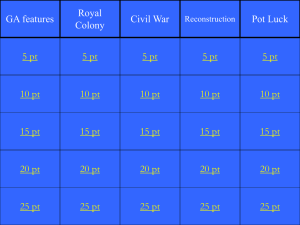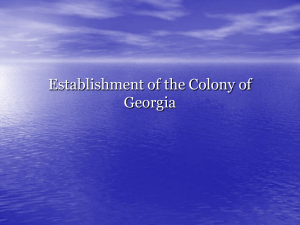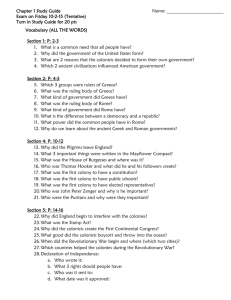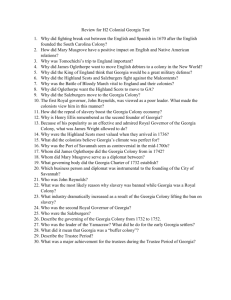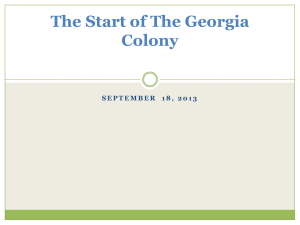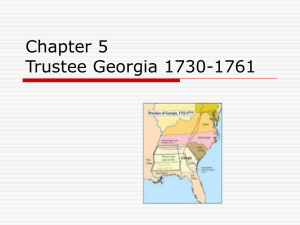Colonization Summary Sheet
advertisement
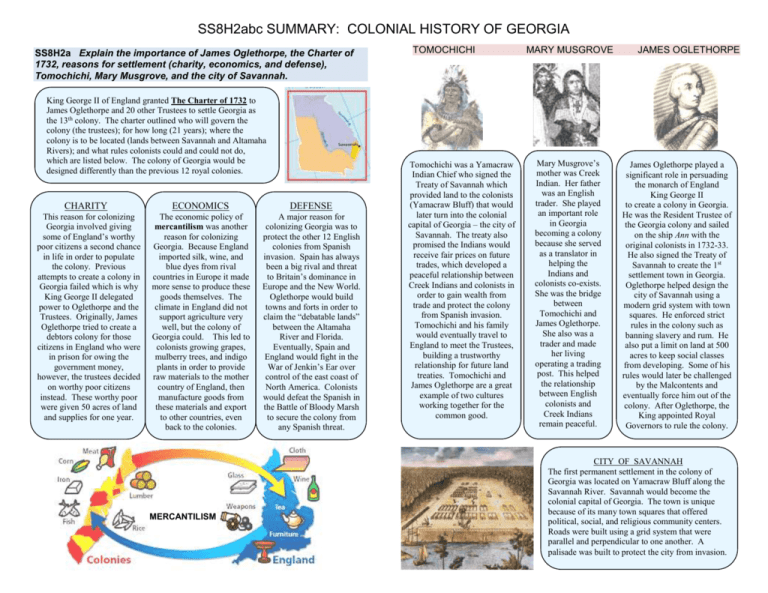
SS8H2abc SUMMARY: COLONIAL HISTORY OF GEORGIA SS8H2a Explain the importance of James Oglethorpe, the Charter of 1732, reasons for settlement (charity, economics, and defense), Tomochichi, Mary Musgrove, and the city of Savannah. King George II of England granted The Charter of 1732 to James Oglethorpe and 20 other Trustees to settle Georgia as the 13th colony. The charter outlined who will govern the colony (the trustees); for how long (21 years); where the colony is to be located (lands between Savannah and Altamaha Rivers); and what rules colonists could and could not do, which are listed below. The colony of Georgia would be designed differently than the previous 12 royal colonies. CHARITY This reason for colonizing Georgia involved giving some of England’s worthy poor citizens a second chance in life in order to populate the colony. Previous attempts to create a colony in Georgia failed which is why King George II delegated power to Oglethorpe and the Trustees. Originally, James Oglethorpe tried to create a debtors colony for those citizens in England who were in prison for owing the government money, however, the trustees decided on worthy poor citizens instead. These worthy poor were given 50 acres of land and supplies for one year. ECONOMICS DEFENSE The economic policy of mercantilism was another reason for colonizing Georgia. Because England imported silk, wine, and blue dyes from rival countries in Europe it made more sense to produce these goods themselves. The climate in England did not support agriculture very well, but the colony of Georgia could. This led to colonists growing grapes, mulberry trees, and indigo plants in order to provide raw materials to the mother country of England, then manufacture goods from these materials and export to other countries, even back to the colonies. A major reason for colonizing Georgia was to protect the other 12 English colonies from Spanish invasion. Spain has always been a big rival and threat to Britain’s dominance in Europe and the New World. Oglethorpe would build towns and forts in order to claim the “debatable lands” between the Altamaha River and Florida. Eventually, Spain and England would fight in the War of Jenkin’s Ear over control of the east coast of North America. Colonists would defeat the Spanish in the Battle of Bloody Marsh to secure the colony from any Spanish threat. MERCANTILISM TOMOCHICHI Tomochichi was a Yamacraw Indian Chief who signed the Treaty of Savannah which provided land to the colonists (Yamacraw Bluff) that would later turn into the colonial capital of Georgia – the city of Savannah. The treaty also promised the Indians would receive fair prices on future trades, which developed a peaceful relationship between Creek Indians and colonists in order to gain wealth from trade and protect the colony from Spanish invasion. Tomochichi and his family would eventually travel to England to meet the Trustees, building a trustworthy relationship for future land treaties. Tomochichi and James Oglethorpe are a great example of two cultures working together for the common good. MARY MUSGROVE Mary Musgrove’s mother was Creek Indian. Her father was an English trader. She played an important role in Georgia becoming a colony because she served as a translator in helping the Indians and colonists co-exists. She was the bridge between Tomochichi and James Oglethorpe. She also was a trader and made her living operating a trading post. This helped the relationship between English colonists and Creek Indians remain peaceful. JAMES OGLETHORPE James Oglethorpe played a significant role in persuading the monarch of England King George II to create a colony in Georgia. He was the Resident Trustee of the Georgia colony and sailed on the ship Ann with the original colonists in 1732-33. He also signed the Treaty of Savannah to create the 1st settlement town in Georgia. Oglethorpe helped design the city of Savannah using a modern grid system with town squares. He enforced strict rules in the colony such as banning slavery and rum. He also put a limit on land at 500 acres to keep social classes from developing. Some of his rules would later be challenged by the Malcontents and eventually force him out of the colony. After Oglethorpe, the King appointed Royal Governors to rule the colony. CITY OF SAVANNAH The first permanent settlement in the colony of Georgia was located on Yamacraw Bluff along the Savannah River. Savannah would become the colonial capital of Georgia. The town is unique because of its many town squares that offered political, social, and religious community centers. Roads were built using a grid system that were parallel and perpendicular to one another. A palisade was built to protect the city from invasion. SS8H2abc SUMMARY: COLONIAL HISTORY OF GEORGIA SS8H2b Evaluate the Trustee Period of Georgia’s colonial history, emphasizing the role of the Salzburgers, Highland Scots, malcontents, and the Spanish threat from Florida. SALZBURGERS HIGHLAND SCOTS SS8H2c Explain the development of Georgia as a royal colony with regard to land ownership, slavery, government, and the impact of the royal governors. MALCONTENTS LAND OWNERSHIP Colonists allowed to own more than 500 acres of land. Land can now be sold and women can inherit land. Large plantations (farms) develop with slave labor producing more profitable crops such as rice, cotton, and tobacco. Social classes develop with planters gaining wealth and power. • Protestant colonists led by Johann Martin Boltzius who migrated to Georgia seeking religious freedom because they were persecuted in Germany / Austria for not being Catholic. They also built the town of Ebenezer along the Savannah River. Some moved to Fort Frederica. They also helped defend the colony from the Spanish invasion, and also opposed slavery due to religious beliefs. Well trained soldiers from Scotland who were recruited by James Oglethorpe to help defend the colony from the Spanish threat in Florida. They built the fort / town of Darien on the southern border of the colony on the Altamaha River. Helped defeat Spanish troops in the Battle of Bloody Marsh. This group also opposed slavery in Georgia. SPANISH THREAT FROM FLORIDA The Battle of Bloody Marsh was an important battle on St. Simons Island in which James Oglethorpe, English colonists, Salzburgers, Highland Scots, and Creek Indians defeated the Spanish who tried to invade Georgia. The Spanish retreated back to Florida, and Georgia claimed the “debatable land” between the Altamaha and St. Mary’s River. The event helped make the colony of Georgia safe and secure allowing the colony to grow geographically and economically. SLAVERY Slavery is legalized in Georgia in 1751 after the Malcontents pressured the trustees to change their policy banning slavery. Only wealthy white landowners could own slaves who worked on rice plantations along Georgia’s coast. Slavery changed the economy of Georgia allowing land owners to grow rich. Slaves were property and had no rights, despite the belief by the Salzburgers, Highland Scots, and many others that slavery was cruel and immoral. Upset colonists who opposed the laws created by the Trustees and wanted Georgia to be more like South Carolina so that they could succeed economically. They wanted rum and slavery to be legalized, and they wanted to own more land and for women to be ableReynolds to John inherit that land.1754-57 The Trustees gave in to their demands and the colony of Georgia changed. Allowed colonists to vote and make laws thru a bicameral legislature. Set up a court system in the colony. However, he became very unpopular and refused to listen to colonists; did not relate to the Indians very well; tried to move the capital out of Savannah. Colonists convinced the King of England to remove him from office (power). Henry Ellis 1757-60 He helped restore the colony by allowing colonists to have a voice in government. He reformed government and helped improve the economy. He improved the colony’s relationship with the Creek Indians and he also divided the colony into parishes (counties) to help government become more efficient. James Wright 1760-76 He was very popular because the economy of Georgia became very developed and rich. The size of Georgia increased to include modern day Mississippi and Alabama and the southern border extended from the Altamaha River to St. Mary’s River. He would remain Royal Governor until the American Revolution.

